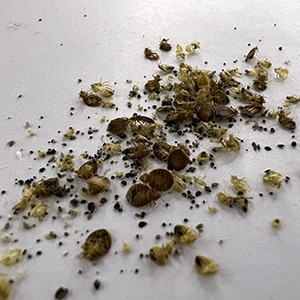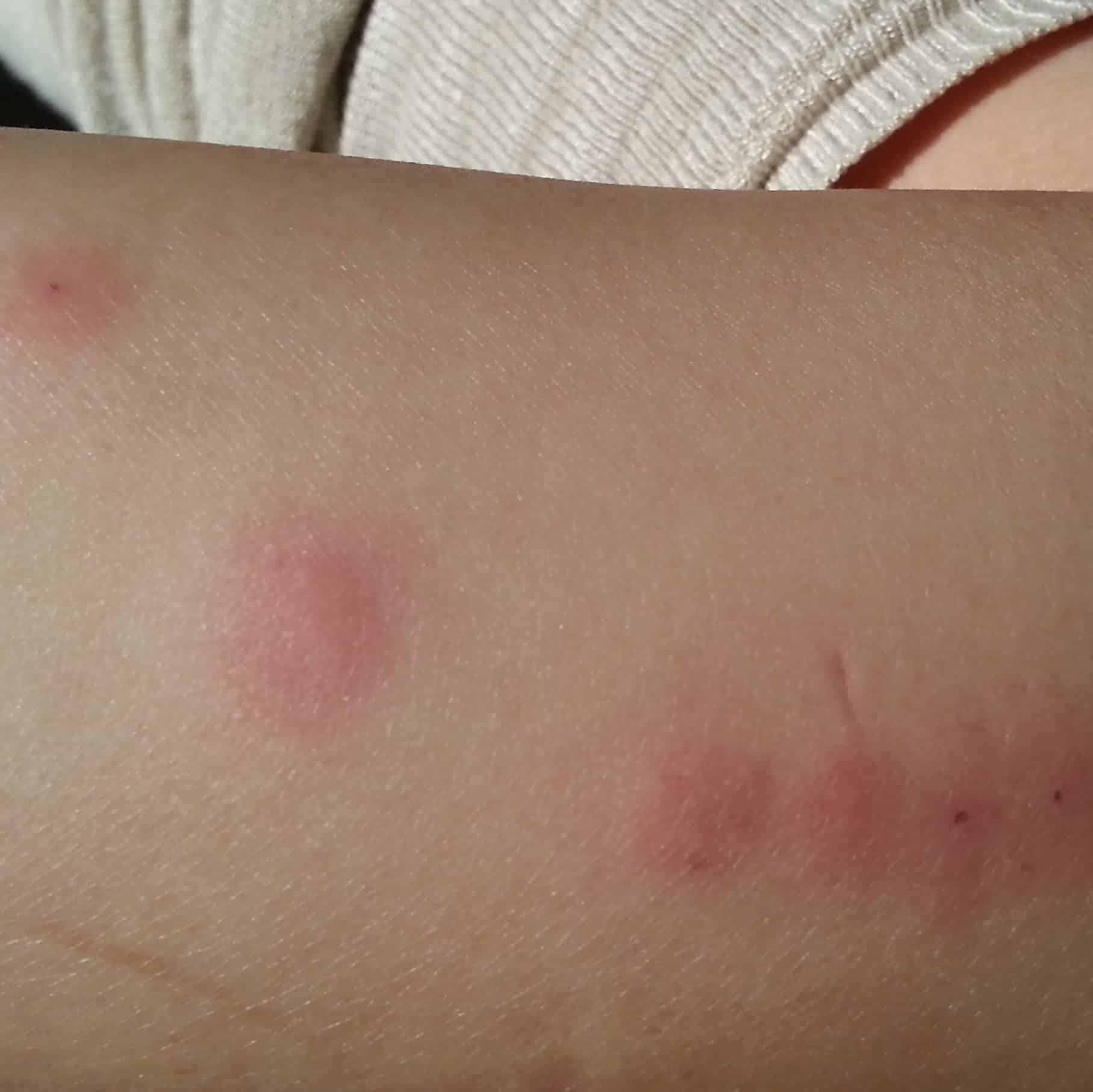
In the article
Bed Bug First Signs
The first signs of bed bugs are the bed bugs themselves, and their fecal stains. While bites might seem like the first sign, they’re not necessarily the earliest. Bed bugs can be an early indicator, but they often go unnoticed because they hide so well.
If bed bugs are present on the bed, they will leave fecal stains. Therefore, the first signs are often fecal spots, but these can go unnoticed since we don’t usually look for them unless we accidentally notice them when making the bed.
What Clues To Look For
Bed bugs are sneaky little critters and their early signs can be easy to miss.
Here’s what to keep an eye out for:
- Live or Dead Bed Bugs: Inspect your mattress and bed frame for bugs.
- Bite Marks: Their bites look like small, red bumps, often in a zigzag pattern. Sometimes, you might even get blisters or hives around the bites.
- Blood Spots: Tiny red or rust-coloured stains on your sheets or clothes can be a sign. These come from squished bugs or fresh bites where the blood didn’t clot.
- Poop Marks: Dark brown or black spots, known as “fecal spotting,” are bed bug droppings. You’ll find these on sheets, mattresses, your skin and other places they hang out.
- Shed Skins: As bed bugs grow, they shed their skins. You might find these empty shells in mattress seams and other hiding spots.
- Weird Smell: Bed bugs give off a musty, sweet odour. At first, it might be faint, but as they multiply, the smell may get stronger.
Pictures of Bed Bug First Signs

Bed Bug First Signs
Catching the first signs of bed bugs early is key to getting rid of them. If you think you’ve got an infestation, act fast to confirm and tackle the problem. For prevention tips, see our guide on diatomaceous earth bed bugs.
What Do Bed Bugs Look Like?
Adult bed bugs (Cimex) are small, flat, oval-shaped, dark brown insects with 6 legs and two antennae that feed at night. When their eggs hatch, they are see-through, but they turn dark brown after they feed for the first time.
| What to Look For | Details |
|---|---|
| Shape | Oval and flat (before eating), tubular (after eating) |
| Color | Dark brown (before eating), dark red (after eating) |
| Size | Adults are about as big as an apple seed |
| Eggs | Tiny, white, like grains of sand |
| Nymphs | Baby bed bugs, smaller and lighter in color |
These bugs can’t fly or jump but can crawl and sometimes drop from high spots. They hide in tiny cracks and crevices during the day and come out at night to feed. They prefer biting humans but will also bite pets.
How They Feed
Bed bugs are night owls, biting their hosts while they sleep. They need blood to grow and move to the next stage of their life cycle. A single female can lay up to 250 eggs in her lifetime, so they can multiply fast.
| Feeding Habit | Details |
|---|---|
| Activity | Nighttime |
| Bite Pattern | Zigzag or straight lines or clusters |
| Bite Size | 5–10 mm in diameter |
| Symptoms | Itching and swelling around bite areas |
Their bites usually show up in clusters or zigzag lines and can cause itching or swelling. They often bite exposed skin like arms, legs, and faces. For more on identifying bites, check our bed with bugs check.
Knowing these details can help you catch bed bugs early. For tips on keeping them away.
Health Implications
Bed bugs might not spread diseases, but they sure can mess with your health. Knowing what to look for helps you catch them early and deal with them fast.
Allergic Reactions
Bed bug bites are those annoying little red bumps that show up on your skin, usually where it’s exposed while you sleep. These bites can trigger allergic reactions, from mild itching to severe hives. Bed bug bites often start as tiny red spots that can turn into blisters or hives if you’re really allergic.
Common symptoms of bed bug bites include:
- Itching
- Swelling
- Redness
- Pain
How To Prevent Bed Bug Infestations
Nobody wants to share their bed with bugs, especially not bed bugs. Here’s how to keep these pesky critters at bay and what to do if they’ve already moved in.
Stopping bed bugs before they get comfy in your home is your best bet. Here’s how:
- Bed Placement: Keep your bed at least a foot away from walls and furniture.
- Barriers and Traps: Use floor barriers and tape around bed legs to stop bed bugs from crawling up.
- Mattress and Pillow Covers: Seal your mattress and pillows in bed bug covers. This traps any bugs inside and keeps new ones out.
- Regular Checks: Inspect your bedding, mattress seams, and furniture regularly. Look for blood stains and tiny black spots (bed bug poop).
- Clean Up: Keep your place tidy. Vacuum carpets, floors, and furniture often to suck up any hiding bugs and their eggs.
- Laundry: Wash and dry your bed linens, curtains, and clothes on high heat. Bed bugs can’t handle the heat.
- Diatomaceous Earth: Dust your bed frame with Bed Bug Powder to kill bed bugs for years to come. It never stops working unless its removed or cleaned up.
How To Install A Bed Bug Cover
Frequently Asked Questions:
- How do you know if bed bugs are starting?
Look for itchy red bites, small blood stains on sheets, dark fecal spots, and shed skin. A musty odour might indicate a severe infestation. - What is the beginning stage of a bed bug?
Bed bugs start as tiny white eggs. They hatch into nymphs, go through five moults, and then become reddish-brown adults about the size of an apple seed. - How long do you have bed bugs before you know it?
It can take weeks or months to notice bed bugs. They start small but reproduce quickly, becoming more obvious over time through bites, stains, and shed skins. - What is the bed bug first signs?
The bed bug first signs are bites, but there will be other signs first like live bed bugs, but they can be hard to see because they hide in cracks and crevices
Are You Looking for an Organic DIY Treatment?
Got Bed Bug First Signs? DIY Treatment Video For An Ensemble Bed
Got Bed Bug First Signs? DIY Treatment Video For A Bed with Slats
If you enjoyed our blog about ‘bed bug first signs’ then you might like to read about bed bug symptoms.
Sources:
MMPC (early signs of bed bugs), Planet Natural (early signs of bed bugs), Forbes (signs of bed bugs)



Leave a Reply